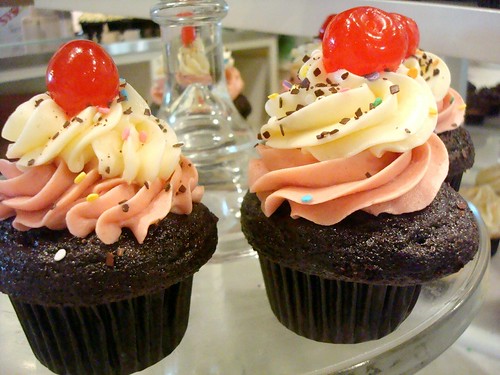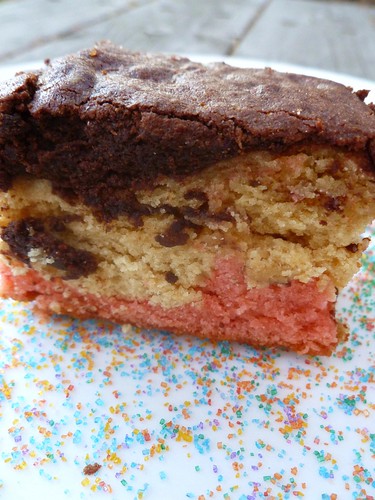 Have you ever found yourself standing by the open freezer door with an open carton of ice cream, trying to spoon every scoop along the chocolate-vanilla line all the way down to the bottom the carton into your mouth without getting ice cream all over your hand the further down the carton you get as a valley of vanilla and chocolate form on either side, hoping that no errant bit of strawberry taints these perfect, yin-and-yang spoonfuls?
Have you ever found yourself standing by the open freezer door with an open carton of ice cream, trying to spoon every scoop along the chocolate-vanilla line all the way down to the bottom the carton into your mouth without getting ice cream all over your hand the further down the carton you get as a valley of vanilla and chocolate form on either side, hoping that no errant bit of strawberry taints these perfect, yin-and-yang spoonfuls?
Wow. Well...uh...neither have I.
But just in case there's anyone who has, in such moments, wondered "what's up with Neapolitan ice cream?", I took a few moments to find out more about its sweet history, with a little who-what-where-when-why-how. Not in that exact order.
First off, what is "Neapolitan"? While I personally think "strawberry-vanilla-chocolate" when I think of Neapolitan, this holy trinity isn't a hard-and-fast rule. Sometimes, other flavors (often pistachio) are included--although not a rule of the dessert, it seems that it is most frequently a trinity of flavors, regardless of what they are.
Apparently trinities are common in the ice cream world?
When did it come about? Believe it or not, it's a fairly new addition to the frozen dessert scene. While ices and granitas date back to ancient times, La Belle Neapolitan only seems to go back to the 1800s. Recipes for the fancy bricks of sweetness rose in popularity in the 19th century--a time at which fancy frozen concoctions were increasing in popularity (the same era during which Baked Alaska became popular in NYC, for instance!).
Interestingly, it seems related to spumoni--a three-flavored (usually a pink--strawberry or cherry--ice cream, paired with chocolate and pistachio).
Why then? Likely owing to the refrigeration advancements that were happening at the time, and as some food historians propose, an increasing interest in "collective gastronomy" (or complicated presentations).
Who is "Neapolitan" named after? According to The Food Timeline, "the peoples of Napoli are credited for introducing their famous ice creams to the world in the 19th century. At that time, pressed blocks composed of special flavors were trendy. The best ones were made with 'Neapolitan-style' ice creams."
As previously noted, this would imply that "Neapolitan" refers more to the concept of several flavors pressed together, not referring to the strawberry-vanilla-chocolate combo which has become by far the most famous trinity of "Neapolitan" flavors. Interestingly, recipes from before 1900 frequently refer to different combinations, in some cases even two flavors of ice cream paired with an ice.
Neapolitan ice cream, as I hear, is nowhere near as popular in Italy as it is in the US, where it has been a popular flavor combination since the 1890s. (Some say, btw, that the American term "Neapolitan" for vanilla, chocolate and strawberry tricolored ice cream is based on its former identification with spumoni.)
Where did it rise in popularity? In spite of its Italian name, the cold and creamy sweet rose to popularity in Paris, not Italy (though the makers were Italian...still with me?). Larousse Gastronomique's words on the subject?
"Neapolitan slice. A slice of ice-cream cake made with mousse mixture and ordinary ice cream, presented in a small pleated paper case. Neapolitan ice cream consists of three layers, each of a different color and flavor (chocolate, strawberry, and vanilla), moulded into a block and cut into slices. Neapolitan ice-cream makers were famous in Paris at the beginning of the 19th century, especially Tortoni, creator of numerous ice-cream cakes."
This is confirmed in the Encyclopedia of Food and Drink:
"(18th century) confectioners's shops (were) very often run by Italians. Consequently ice creams were often called "Italian ice creams" or "Neapolitan ice creams" throughout the 19th century, and the purveying of such confections became associated with Italian immigrants."
Also interesting? How it's made commercially. Here's an interesting morsel about the production process in the modern day; also, Wikipedia pointed me toward Cassell's New Universal Cookery Book, which informed me that something exists called the Neapolitan Ice Spoon.
The Neapolitan Ice Spoon has a double use; ice bowl is for putting the mixture into the mold, and the handle is for leveling it. The boxes may be made of tin, which is less expensive than pewter. They are generally sold small enough to make single ices, but these are much more troublesome to prepare. After filling the molds, if there is no cave, "bed" the ice in the usual way.
Well, no matter how you slice it (or spoon it), Neapolitan is a combination which is as iconic as it is delicious, inspiring candies, trinkets that look like candies, dresses, artwork, cakes, rice krispie treats (!) and even blondie bars.
Conclusion? no matter who made it or where it's from, that strawberry-vanilla-chocolate confection is a trinity of awesome that is part of our hearts, via our greedy, sugar-hungry mouths.




